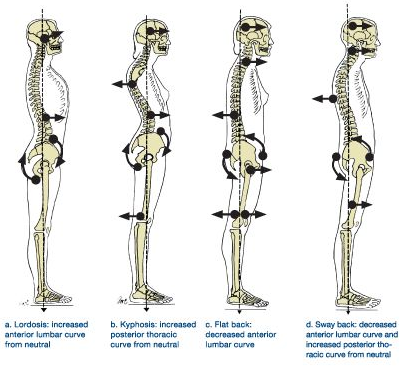
Posture and Alignment
Pilates has increased in popularity as the go to training for proper posture and alignment.
Posture can be described in terms of alignment of the joints and boney landmarks and may be understood in terms of muscle balance and function.
The ideal plumb line is when the ear, shoulder, hip joint, knee and ankle are all in a straight line.
Alignment deviations from this view will appear in the sagittal place. The following are points that should fall on this line when "ideal" alignment is thought of.
- Lobe of ear
- Through bodies of cervical vertebra
- Shoulder joint
- Midway through trunk
- Greater trochanter of femur
- Slightly anterior to the midline through knee
- Slightly anterior to lateral malleolous
Faulty posture has been identified as the following, however the change of evolution as more and more people are sitting and on mobile devices this list may be modified.
Improper alignment results in undue stress and strain on bones, joints, ligaments and muscles. It is important to understand the difference of postural deviation, either derived from structural or functional which is learned.
Below is an illustration for reference:
Hyper Lordosis/Hyper Kyphosis
Head - Forward
Cervical Spine - Hyperextended
Scapula - Abducted (protracted)
Thoracic Spine - Increased flexion (posterior to plumb line)
Lumbar Spine - Hyperextended (anterior to plumb line)
Pelvis - Anterior Tilt
Hip Joint - Flexed
Knee Joint - Slightly hyperextended
Ankle Joint - Slightly plantar flexed (due to backward inclination of leg)
Hip Flexors - Short and strong
Flat Back
Head - Forward
Cervical Spine - Slightly extended
Thoracic Spine - Upper-increased flexion, lower-straight
Lumbar Spine - Straight (flexed)
Pelvis - Posterior tilt
Hip Joint - Extended
Knee Joint - Extended
Ankle Joint - Slightly plantar flexed
Hamstrings - short and strong
Sway Back (Fatigue)
Head - Forward
Cervical Spine - Slightly extended
Thoracic Spine - Long Kyphosis (increased flexion) with posterior displacement of trunk
Lumbar Spine - Flattened lower back
Pelvis - Posterior Tilt
Hip Joint - Hyperextended with anterior displacement of pelvis
Knee Joint - Hyperextended
Ankle Joint - Neutral
Hamstrings - Short and strong
Internal Obliques - Strong, not short
Not illustrated in diagram above:
Handedness
Dominant Side = Over developed musculature
Asymmetries = Weak on one side, strong on other
Imbalance = Tight on one side, flexible on other
Scoliosis
Lateral curvature of spine, usually involving rotation of vertebrae. Appears in C curve of S curve.
The lateral deviation should be greater than 10 degrees (by x-ray) from the normal vertical line of the spine to be considered Scoliosis. A complex condition.
Hyperextension
Knees - lengthened hamstrings and gastrocnemius, shortened and tight quadriceps.
Knock Knees (Genu valgus)
Femur rotating externally, knees adducting
Bow Legs (Gena vargus)
Femur rotating internally, knees abducting
Type of Foot Alignment
The feet form the base of the body when erect and therefore will influence the entire structure. Clearly correct alignment of the fee and well-balanced musculature is fundamental to good posture and functional body mechanics.
Pronation
"Rolling In" - weak and lengthened medial aspect of foot, short and tight laterally.
Supination
'Rolling Out" - weak and lengthened laterally, short and tight medially.
